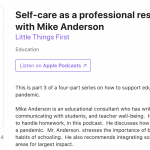Help Students Choose to Learn
This session summary appeared in the Conference Daily, the daily newspaper for the ASCD Annual Conference in Atlanta, GA, April 2-4, 2016. The original link is: http://annualconference.ascd.org/attendee/conference-daily/2016/choose-to-learn.aspx.
April Bailey
Too often, students figure out what they’re supposed to do based solely on what the teacher tells them to do, according to ASCD Author Mike Anderson. In his session, “Joyful Challenge through Choice,” Anderson described some of the benefits of offering students choices in their learning.
As a teacher, you want to create choices that meet your learning goals, match what you know about your students, and can be completed with the time, resources, and environment you have.
For example, if you’re introducing new vocabulary words to students, you can provide them with options for how to learn these new words. These options could include writing complete sentences using each word, drawing a picture that represents each word, or creating flash cards to review words.
One benefit of choice is that it teaches students self-differentiation. Anderson said students can weigh their options by considering three categories. One category is too hard. When students find an assignment to be too hard, they become stressed and disengaged, which results in little learning.
Another category is too easy. If assignments are too easy, students become bored, which also results in disengagement and little learning. The last category is just right. With these types of assignments, students are appropriately challenged and highly engaged, and they experience joy while learning. You can help students make the right choices by giving them options they can place into this category.
A second benefit of choice is intrinsic motivation. Students become excited about assignments they have personal interest in. This means you’re less likely to get asked, “Is this going to be graded?”
A third benefit of choice is that it reduces misbehaviors. Anderson said at-risk students are often not allowed much choice when it comes to the way they learn. However, when they are allowed to choose, they gain a sense of self-empowerment and become more engaged in learning.
One of the biggest benefits of choice for educators is that teaching becomes more fun. When you see your students learning, growing, and getting excited about their work, you become just as excited, if not more.
After students choose from the options you provide, allow time for them to work on the assignment, and be sure to coach and guide them throughout the process. When the assignment is done, have students review their work and consider what parts of the assignment they enjoyed the most and what parts they would do differently if given the assignment again.
Take time to personally reflect as well. Ask yourself how well the students received the assignment students and whether you can use some of the options you provided again or if you need to develop new ones. Share your strategies with colleagues to receive additional guidance.
Anderson said one of the challenges with providing students with choices is that it means sharing some power and control. As a teacher, you can’t help but wonder what will happen if your students make the wrong choices. He said teachers should allow their students to learn from the experience of making the wrong choice, especially when it comes to shorter assignments. However, for longer assignments teachers should not be afraid to intervene if a student makes a choice that is not beneficial to their learning.
You can learn more about creating choices and helping students choose by checking out Anderson’s book Learning to Choose, Choosing to Learn: The Key to Student Motivation and Achievement.




